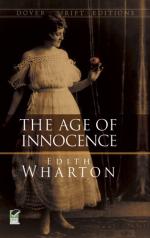|
This section contains 2,408 words (approx. 9 pages at 300 words per page) |

|
The Age of Innocence
Summary: Analyzes Edith Wharton's novel, The Age of Innocence. Describes how Wharton presents characters who are bound by a social code which is repressive and pervasive in its hold over the inhabitants of New York. Through focused analysis of characterisation, imagery, style and tone, examines Wharton's presentation of society and the impact it has on the lives of the characters.
Wharton's "ironic masterpiece", written in 1920 but based in the 1870's, may be argued to be critical of the "old New York" in which she grew up in, or may be a nostalgic, sentimental remembrance of her childhood and society. I believe however, like the critic Jerry Clyde Phillips, that it is the combination of nostalgia and criticism through Wharton's satire and irony that makes her "looking back at her youth... neither too sentimental nor too critical, but simply a fond remembrance of the time and place in which she lived." The fact that Wharton tells us that Archer "cherished his old New York even while he smiled at it" in Chapter Eight reflects Wharton's own true feelings about her old society.
Wharton uses Archer even further in her novel to represent the "repressive and pervasive" nature of 1870's society through his two relationships with the Countess Olenska and...
|
This section contains 2,408 words (approx. 9 pages at 300 words per page) |

|


